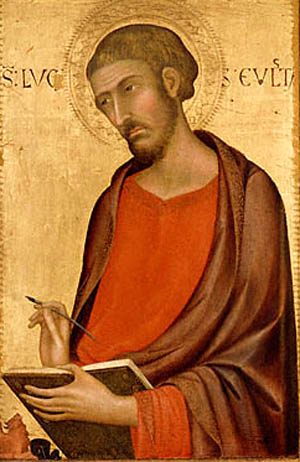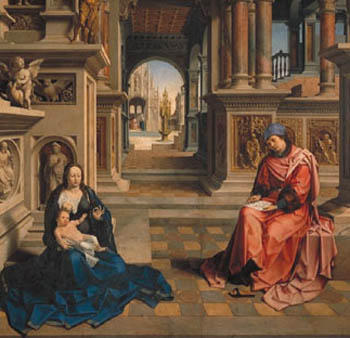 |
The Saint of the Day
St. Luke the Evangelist – October 18
Prof. Plinio Corrêa de Oliveira
Biographical selection:

St. Luke by Simone Martini
|
Luke was born in Antioch to pagan Greek parents. St. Paul met him at Troas and invited him to accompany him into Macedonia where they traveled first to Samothrace, Neapolis, and finally Philippi about the year 51. Later, he became the constant companion of St. Paul, following him everywhere. He alone remained with Paul when he was imprisoned in Rome about the year 61.
After St. Paul’s death, St. Luke left Rome. There are conflicting reports about where he went. Some say he preached in Greece, others in Gaul. He wrote his Gospel with the aim of attracting the Gentiles to the goodness and mercy of the Lord. A little later he wrote the Acts of the Apostles.
He died without shedding his blood, but the Church honored him with the title of martyr for the long sufferings and mortifications he endured for the cause of the Gospel.
Comments of Prof. Plinio:
We will analyze the special graces the Our Lord gave to St. Luke through the certain facts we know about his life. He was the companion of St. Paul, the author of one of the four Gospels, and also author of the Acts of the Apostles.

Picture of Our Lady painted by St. Luke in Santa Maria Maggiore Basilica
|
We can imagine the moral qualities of a man chosen by St. Paul to be his companion on trips. He would have to be a man eminently able to assist St. Paul’s apostolic activities. He would have an extraordinary apostolic ardor and a special gift to form and deal with the new disciples that St. Paul was attracting to the Catholic Faith.
He also was able to understand the life of Our Lord Jesus Christ so profoundly that the Holy Ghost chose him to collect the data of His life and write it. Analogously, he understood perfectly the life of the nascent Church and wrote about it in the Acts of the Apostles, which is the first report of the History of the Church.
To do those three things he must have been a true vessel of the Holy Ghost.
The graces one receives reading the Gospel of St. Luke and the Acts of the Apostles certainly come to us from the Holy Ghost. But they also reflect the soul of St. Luke who wrote them. The light of the Holy Ghost comes to us through the stained glass windows of his writings. There are special characteristics in those writings that are his alone. It is also known that he was very devoted to Our Lady. The first painting of Our Lady is attributed to him. Today it is venerated in the Basilica of Santa Maria Maggiore in Rome.

St. Luke painting the Blessed Virgin
|
I suppose that Our Lady did not pose for him, but rather that he saw her many times and had her figure in mind to reproduce in a painting. So, we can imagine him silently admiring this or that facet of her physiognomy, and then reproducing it in the picture he was painting. Another time, he would perhaps glimpse another aspect and retouch his painting.
What a marvelous work that would be - with Our Lord blessing him from Heaven and the Angels smiling at his labor to perfect in his painting the face of the Queen of Heaven and Earth.
All this is beautiful and grandiose, and we cannot find sufficient words of praise for his life. We cannot describe it, but only admire it. I believe that by admiring the soul of St. Luke, a little of his extraordinary qualities and virtues may trickle into our souls.


Watch a video illustration of this Saint of the Day article
here

  | | Prof. Plinio Corrêa de Oliveira | |
The Saint of the Day features highlights from the lives of saints based on comments made by the late Prof. Plinio Corrêa de Oliveira. Following the example of St. John Bosco who used to make similar talks for the boys of his College, each evening it was Prof. Plinio’s custom to make a short commentary on the lives of the next day’s saint in a meeting for youth in order to encourage them in the practice of virtue and love for the Catholic Church. TIA thought that its readers could profit from these valuable commentaries.
The texts of both the biographical data and the comments come from personal notes taken by Atila S. Guimarães from 1964 to 1995. Given the fact that the source is a personal notebook, it is possible that at times the biographic notes transcribed here will not rigorously follow the original text read by Prof. Plinio. The commentaries have also been adapted and translated for TIA’s site.
|
Saint of the Day | Home | Books | CDs | Search | Contact Us | Donate

© 2002- Tradition in Action, Inc. All Rights Reserved
|
 |

|